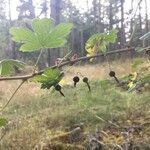Plants 1-3 m. Stems erect to spreading, ± pubescent through-out; spines at nodes absent or 1-3, 5-20 mm; prickles on internodes absent or sparse. Leaves: petiole 1-3 cm, pilose with glandular and eglandular hairs, some plumose hairs at base; blade roundish to nearly reniform, 3-(or 5-)lobed, cleft 1/2 to midrib, proximal segments again shallowly cleft into 2 unequal lobes, 2-3.5 cm, base rounded to cordate, surfaces pubescent abaxially, subglabrous or finely pubescent adaxially, lobes cuneate, margins prominently crenate-serrate, apex rounded. Inflorescences pendent, solitary flowers or 2-4-flowered racemes, 2-4 cm, axis glabrous or pilose, flowers evenly spaced. Pedicels not jointed, 3-12 mm, glabrous or pilose; bracts oval, 1-2 mm, glabrous or ciliate with stiff hairs and glands. Flowers: hypanthium greenish or purplish, obconic, 1.5-3.5 mm, glabrous or copiously pubescent; sepals not overlapping, spreading-reflexed, red or reddish or purplish green, narrowly oblong-deltate, 3.4-6 mm; petals distally nearly connivent to overlapping, erect, white or pink to red, cuneate-lunate to obovate, not conspicuously revolute or inrolled, 1.2-3 mm; nectary disc not prominent; stamens 2.5-3.5 times as long as petals; filaments linear, 3.5-7 mm, glabrous; anthers cream, oval, 1 mm, apex rounded; ovary glabrous; styles connate ca. 1/2 their lengths, 5-11 mm, copiously pilose-villous in proximal 3/4. Berries palatable, purplish black, subglobose, 6-12 mm, glabrous. 2n = 16.
More
A shrub. It can be erect or spreading. It loses its leaves during the year. It grows 2 m tall and the branches spread over. The bark is smooth and grey. The stems have 1-3 stout spines at each nodes. The leaves are small and have 3-5 lobes. The flowers are small and red or green. They occur in drooping clusters. The fruit is a smooth black berry.
Stream-sides, woods, open forests, edges of meadows, thickets, roadsides, fencerows; at elevations up to 600 metres. Open woods, prairies and moist hillsides.
More
It is a temperate plant. It grows in open woods and along the coastline.

